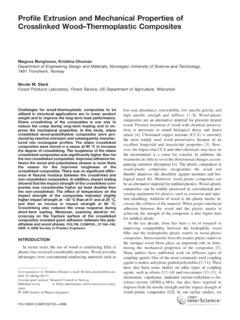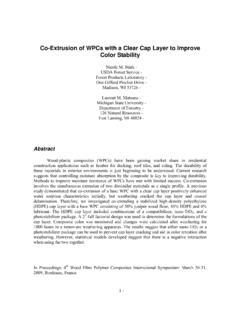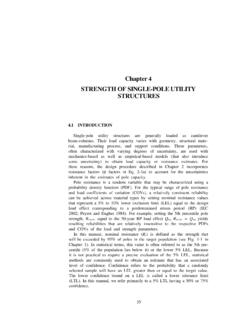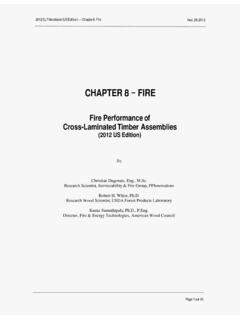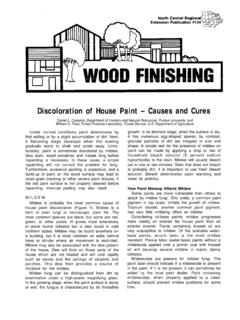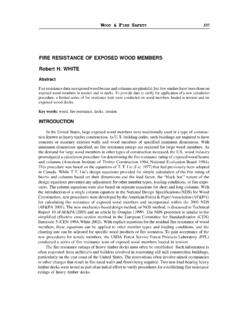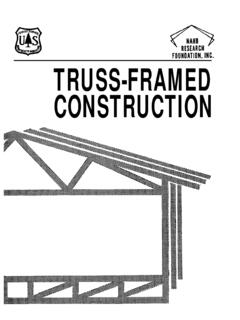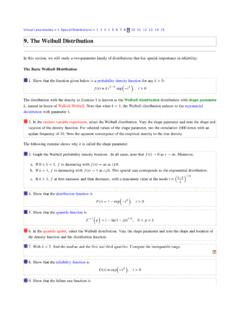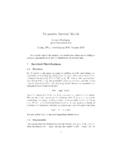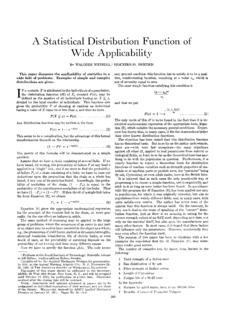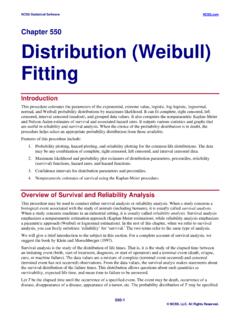Transcription of Procedures for estimation of Weibull parameters
1 Procedures for estimation of Weibull ParametersJames W. EvansDavid E. KretschmannDavid W. GreenUnited States Department of AgricultureForestServiceForest ProductsLaboratoryGeneral Technical ReportFPL GTR 264 February2019 Abstract The primary purpose of this publication is to provide an overview of the information in the statistical literature on the different methods developed for fitting a Weibull distribution to an uncensored set of data and on any comparisons between methods that have been studied in the statistics literature. This should help the person using a Weibull distribution to represent a data set realize some advantages and disadvantages of some basic methods. It should also help both in evaluating other studies using different methods of Weibull parameter estimation and in discussions on American Society for Testing and Materials Standard D5457, which appears to allow a choice for the method to estimate the parameters of a Weibull distribution from a data set.
2 Because in D5457 the method to estimate parameters is to some extent optional, the resulting fitted distribution used to derive the reference resistance properties of wood-based materials and structural connections might result in different values developed under the standard. The maximum-likelihood method appears to be the method that should be used as the default, with other methods requiring some type of justification for their use in wood utilization research. Keywords: Weibull distribution , estimation of parameters , maximum likelihood estimation , regression estimators, simple percentile estimators, method of moments February 2019 Evans, James W.; Kretschmann, David E.; Green, David W. 2019. Procedures for estimation of Weibull parameters . General Technical Report FPL GTR 264.
3 Madison, WI: Department of Agriculture, Forest Service, Forest Products Laboratory. 17 p. A limited number of free copies of this publication are available to the public from the Forest Products Laboratory, One Gifford Pinchot Drive, Madison, WI 53726-2398. This publication is also available online at Laboratory publications are sent to hundreds of libraries in the United States and elsewhere. The Forest Products Laboratory is maintained in cooperation with the University of Wisconsin. The use of trade or firm names in this publication is for reader information and does not imply endorsement by the United States Department of Agriculture (USDA) of any product or service. Contents 1 Introduction .. 1 2 Background .. 1 3 estimation Procedures .
4 1 4 Historical Comparisons of Individual Estimator Types .. 8 5 Other Methods of Estimating parameters of the Weibull distribution .. 11 6 Discussion .. 12 7 Conclusion .. 13 8 References .. 14 In accordance with Federal civil rights law and Department of Agriculture (USDA) civil rights regulations and policies, the USDA, its Agencies, offices, and employees, and institutions participating in or administering USDA programs are prohibited from discriminating based on race, color, national origin, religion, sex, gender identity (including gender expression), sexual orientation, disability, age, marital status, family/parental status, income derived from a public assistance program, political beliefs, or reprisal or retaliation for prior civil rights activity, in any program or activity conducted or funded by USDA (not all bases apply to all programs).
5 Remedies and complaint filing deadlines vary by program or incident. Persons with disabilities who require alternative means of communication for program information ( , Braille, large print, audiotape, American Sign Language, etc.) should contact the responsible Agency or USDA s TARGET Center at (202) 720 2600 (voice and TTY) or contact USDA through the Federal Relay Service at (800) 877 8339. Additionally, program information may be made available in languages other than English. To file a program discrimination complaint, complete the USDA Program Discrimination Complaint Form, AD-3027, found online at and at any USDA office or write a letter addressed to USDA and provide in the letter all of the information requested in the form. To request a copy of the complaint form, call (866) 632 9992.
6 Submit your completed form or letter to USDA by: (1) mail: Department of Agriculture, Office of the Assistant Secretary for Civil Rights, 1400 Independence Avenue, SW, Washington, 20250 9410; (2) fax: (202) 690 7442; or (3) email: USDA is an equal opportunity provider, employer, and lender. 1now President, American Lumber Standard Committee, Inc., Frederick, Maryland, USA 1 Introduction Two-parameter and three-parameter Weibull distributions are widely used to represent the strength distribution of structural lumber and engineering-designed wood subassemblies. Current design practices for wood and related material are based on an estimated fifth percentile of the strength distribution . This deterministic method of design is known as allowable stress design (ASD).
7 Although the fifth percentile can be based on a distributional form, such as the Weibull distribution , the real interest in the Weibull distribution is occuring as wood construction practices in the United States and Canada are revised from deterministic Procedures to reliability-based design (RBD) Procedures . The two-parameter Weibull distribution is the underlying basis of the calculations in load and resistance factor design (LRFD), a subset of RBD that is discussed in American Society for Testing and Materials (ASTM) D5457 04a (ASTM 2009). This design procedure starts with fitting a two-parameter Weibull distribution to either a complete data set or a set of data representing the lower tail of the distribution . The fit can be made using either maximum-likelihood methods or a regression-based estimation procedure.
8 Initially, the standard also considered a method of moments estimate, but this was dropped before the standard was approved. Because of the sensitivity of reliability calculations to the distributional form and, potentially, method of fit, the wood engineering community is interested in looking at (1) evaluating the effect of using a two-parameter instead of a three-parameter Weibull distribution , (2) the effect of estimation method, and (3) the effect of using censored data sets compared with using full data sets. Simulations such as those performed by Durrans and others (1998) encouraged the wood community to address some of these issues. Unfortunately, there is a general lack of knowledge in the wood community of the extensive work available in the statistics literature on these issues, which could lead to needless work in areas in which the information is already available.
9 The primary purpose of this publication is to provide an overview of the basic information in the statistical literature on the different methods developed for fitting a Weibull distribution to an uncensored set of data and on any comparisons between methods that have been studied in the statistics literature. This report is not meant to be a complete summary of all the literature available on the Weibull distribution . It is intended to provide basic information on the more well-known methods for estimating Weibull parameters from data. We start by giving background on the Weibull distribution . 2 Background The Weibull distributional form (Eq. (1)) was first derived through an extreme-value approach by Fisher and Tippett (1928). As noted by Mann (1968), it became known as the Fisher Tippett Type III distribution of smallest values or as the third asymptotic distribution of smallest (extreme) values.
10 In 1939, a Swedish scientist, Waloddi Weibull (1939a), derived the same distribution in an analysis of breaking strengths using only certain practical requirements. Several examples of its use were given by Weibull (1951). Two other papers by Weibull (1939b, 1952) also used the distribution . Use of the distribution became common in reliability analyses after World War II, and the name Weibull became firmly associated with the distribution . In its three-parameter form, the Weibull family is represented by the density function, ( )(){}(){}11/exp/aafx ab xc bxc b = (; ,0)x cab>> (1) where a is the shape parameter, b the scale parameter, and c the location parameter. A more common representation of the Weibull distribution in the wood community is to use the cumulative distribution function, ( )(){}1 exp/aFxx c b = (2) The family of two-parameter Weibull distributions follows from Equation (1) when c = 0.
